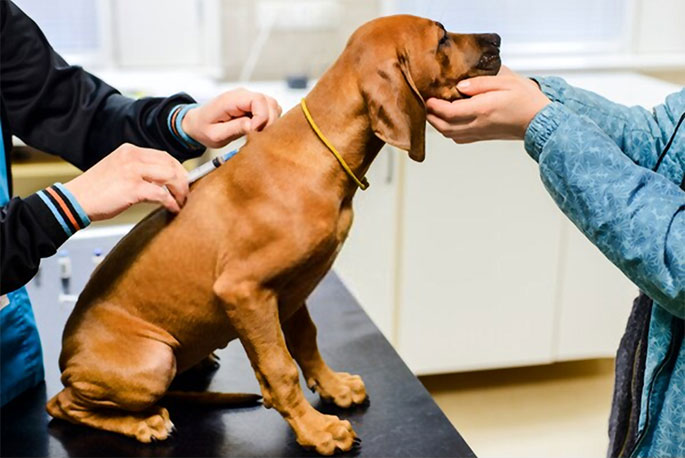
Are you afraid that your dog may be suffering from distemper, but aren’t sure?
Distemper is actually one of the most serious canine diseases. However, it’s also one of the most preventable. But, what is distemper in dogs? What are the signs of distemper?

Read More:
- 3 Ways To Spot Health Problems In Newborn Puppies
- Why Is My Dog Shaking?
- Necessary Routine Care Tips For Dogs That You Shouldn’t Skip
- Five Ways to Ensure Your Puppy’s Health
- 3 Amazing Scent Games for Your Dog
If you think your dog may be suffering from distemper, you’ve come to the right place.
Read on to learn everything you need to know about distemper in dogs.
What Is Distemper in Dogs?
First things first, what exactly is distemper?
Canine distemper is a virus that affects a dog’s central nervous, gastrointestinal, and respiratory system, as well as the conjunctival membranes of the eye.
This is a contagious and serious disease, and in addition to being found in dogs, distemper is also found in foxes, coyotes, wolves, skunks, raccoons, minks, ferrets, and other wild animals.
The virus is closely related to rinderpest viruses and measles. It’s potentially deadly and highly contagious.
Luckily, there’s a vaccination available for the disease.
How is it Spread?
Canine distemper can be spread in three different ways:
- Through airborne exposure
- Through direct contact with an infected animal or object
- Through the placenta
While the virus can be spread a number of different ways, the good news is that it doesn’t last long in the environment. Most disinfectants can kill the virus before it causes harm. However, a dog suffering from distemper can shed the virus for up to several months, which will put the dogs around them at risk.
What are the Symptoms of Distemper?
So, how can you tell if your dog has distemper?
If your dog has distemper, it’ll experience a wide range of symptoms depending on how advanced the disease is. Once a dog becomes infected with the virus, it replicates in the respiratory tract. It then moves onto the lymphatic tissue, the GI tract, the central nervous system, the urogenital epithelium, and the optic nerves.
As a result, there are two stages of symptoms.
Stage One
The first symptom of distemper discharge from the eyes. This is usually followed by a fever, nasal discharge, and a loss of appetite. After being infected by the virus, most dogs will start experiencing a fever within 3 to 6 days. In general, these are the symptoms your dog will experience in the initial stage of distemper:
- Fever
- Vomiting
- Diarrhea
- Clear nasal discharge
- Pustular dermatitis
- Purulent eye discharge
- Inflammation of the spinal cord and brain
- Anorexia
- Lethargy
- Coughing
Some dogs also experience a secondary bacterial infection as a result of distemper. This happens when the immune system is compromised. Symptoms of a secondary bacterial infection include:
- Diarrhea
- Vomiting
- Change in respiratory rate
- Difficulty breathing
- Pneumonia
Stage Two
As the disease progresses and attacks the central nervous system, some dogs develop symptoms. These include:
- Convulsions with increased chewing motions and salivation
- Muscle twitching
- Head tilt
- Circling
- Partial or full paralysis
- Repetitive eye movements
- Seizures
- Death
Dogs with distemper will present some or all of these symptoms. As we mentioned earlier, the symptoms your dog displays will depend on the severity of the infection. Even if your dog does survive distemper, they’ll likely suffer from permanent and irreparable nervous system damage.
All dogs are at risk of developing distemper. However, puppies under four months old and unvaccinated dogs are particularly susceptible to this infection. If your dog shows any signs of distemper, you should call your vet immediately.
How to Treat Distemper in Dogs
Unfortunately, there’s no cure for distemper. Your veterinarian can diagnose distemper through a combination of diagnostic tests and clinical signs. It can also be diagnosed through a postmortem necropsy.
Once your dog has been diagnosed, the care you can offer them is purely supportive. Your vet can treat vomiting, diarrhea, and neurological symptoms. They can also help prevent dehydration and secondary bacterial infections.
The length of the infection and survival rate will depend on the strength of the virus as well as your dog’s immune system. This can be anywhere from 10 days to a few months.
Preventing Distemper
The good news is that canine distemper is 100 percent preventable. Here’s what you can do to prevent the infection:
- Have your puppy get the full series of distemper vaccinations
- Keep your dog away from wildlife and infected animals
- Avoid any gaps in vaccinations and make sure their vaccinations are up-to-date throughout their life
- Be wary about socializing your puppy with unvaccinated dogs
Dog Distemper Vaccination
So, what exactly does the distemper vaccination consist of?
Typically, the distemper shot is combined with vaccinations for parainfluenza, parvovirus, leptospirosis, adenovirus 2, and sometimes coronavirus. Your puppy will receive a series of shots, beginning when it’s 6 to 8 weeks old. Then they’ll receive shots every 4 weeks until they’re 16 weeks old.
The next vaccine should be administered a year later, with boosters every 1 to 3 years after that. Some vets automatically vaccinate on a regular basis at your dog’s annual checkup. Others will test your dog’s antibodies to decide if boosters are necessary.
More and more vets are turning to blood tests to decide if vaccination is necessary, as research shows that too many vaccinations can cause harm to your pooch.
What is Distemper in Dogs?: Wrap Up
Now that we’ve answered the question, “What is distemper in dogs?” you should have a better idea of whether or not your dog is suffering from distemper.
If the answer is yes, then you should get your dog to the vet immediately. And, even if the answer is no, remember that you still need to keep up with your vaccinations in order to prevent your dog from developing the infection.
If you enjoyed reading this article, be sure to check back in with our blog for more tips and tricks for caring for your pet.
Popular Posts:



